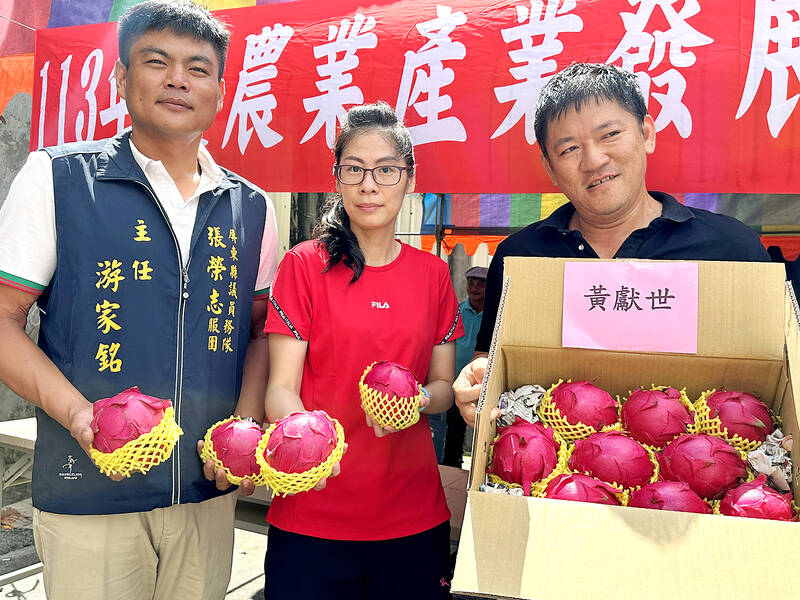Red dragon fruit exports are expected to reach 338 tonnes this year, while Jinhuang mangoes could be exported to Japan next year, Deputy Minister of Agriculture Hu Jong-i (胡忠一) said yesterday.
The ministry on Monday sent a test shipment of 192kg of red dragon fruit to Japan following eight years of negotiations, Hu said, adding that the fruit was well-received and a shipment of 6 tonnes would be sent on Tuesday.
A total of 338 tonnes of the fruit is expected to be exported to Japan by the end of this year, and would increase next year, he said.

Photo: Tsai Tsung-hsien, Taipei Times
“We negotiated with Japan for eight years on the sale of red dragon fruit, and I last met with Japanese officials on May 28,” he said.
Taiwan has exported the white-fleshed variety of dragon fruit to Japan since 2010.
The nation currently exports 50 kinds of fruit to foreign markets, but only 11 are permitted for sale in Japan, Hu said.
“We would also start exporting Jinhuang mangoes to Japan next year,” he said. “We already sell other varieties of mango in Japan, including Haden mangoes and Taiwan’s Aiwen mangoes.”
The ministry hopes to complete bilateral quarantine negotiations with Japan as soon as possible, after which it would instruct farmers on how to handle fruit in accordance with Japan’s quarantine regulations, he said.
The ministry on June 5 finished negotiations with Japan on the export of red dragon fruit, and on Monday, processing plants in Taiwan implemented the packaging requirements set by Japan, Hu said.
Japanese quarantine regulations stipulate that the center point of the fruit must reach 46.5°C for 30 minutes before being shipped, he said.
Taiwan would export red dragon fruit to Japan under the Taiwan Good Agricultural Practice 2020 Plus food processing standards, he said.
The fruit would account for 1 percent of the Japanese market, with plans to increase exports annually, he said.
“Japan currently imports red dragon fruit mainly from Vietnam. Although Taiwan produces less of the fruit, the Taiwanese variant has a higher anthocyanin content, and is sweeter and larger,” he said, adding that the price of the Taiwanese red dragon fruit would be 50 percent more.
Separately, the ministry said that Taiwanese fruit in New Zealand had been selling well, with exports of lychees to New Zealand reaching US$172,000 last year.
Exports to the country would rise after Wellington in April approved the importation of Taiwanese pineapples, it said.
Meanwhile, sales of orchids and grouper to the US, and pork to the Philippines were also rising, with one container of product exported to the countries monthly, it said.
Overall, agriculture exports had increased 4.68 percent since 2016, it said.

The Coast Guard Administration (CGA) and Chunghwa Telecom yesterday confirmed that an international undersea cable near Keelung Harbor had been cut by a Chinese ship, the Shunxin-39, a freighter registered in Cameroon. Chunghwa Telecom said the cable had its own backup equipment, and the incident would not affect telecommunications within Taiwan. The CGA said it dispatched a ship under its first fleet after receiving word of the incident and located the Shunxin-39 7 nautical miles (13km) north of Yehliu (野柳) at about 4:40pm on Friday. The CGA demanded that the Shunxin-39 return to seas closer to Keelung Harbor for investigation over the

An apartment building in New Taipei City’s Sanchong District (三重) collapsed last night after a nearby construction project earlier in the day allegedly caused it to tilt. Shortly after work began at 9am on an ongoing excavation of a construction site on Liuzhang Street (六張街), two neighboring apartment buildings tilted and cracked, leading to exterior tiles peeling off, city officials said. The fire department then dispatched personnel to help evacuate 22 residents from nine households. After the incident, the city government first filled the building at No. 190, which appeared to be more badly affected, with water to stabilize the

EARTHQUAKE: Taipei and New Taipei City accused a construction company of ignoring the Circular MRT’s original design, causing sections to shift by up to 92cm The Taipei and New Taipei City governments yesterday said they would seek NT$1.93 billion (US$58.6 million) in compensation from the company responsible for building the Circular MRT Line, following damage sustained during an earthquake in April last year that had shuttered a section for months. BES Engineering Corp, a listed company under Core Pacific Group, was accused of ignoring the original design when constructing the MRT line, resulting in negative shear strength resistance and causing sections of the rail line between Jhonghe (中和) and Banciao (板橋) districts to shift by up to 92cm during the April 3 earthquake. The pot bearings on

DEEPER REVIEW: After receiving 19 hospital reports of suspected food poisoning, the Taipei Department of Health applied for an epidemiological investigation A buffet restaurant in Taipei’s Xinyi District (信義) is to be fined NT$3 million (US$91,233) after it remained opened despite an order to suspend operations following reports that 32 people had been treated for suspected food poisoning, the Taipei Department of Health said yesterday. The health department said it on Tuesday received reports from hospitals of people who had suspected food poisoning symptoms, including nausea, vomiting, stomach pain and diarrhea, after they ate at an INPARADISE (饗饗) branch in Breeze Xinyi on Sunday and Monday. As more than six people who ate at the restaurant sought medical treatment, the department ordered the